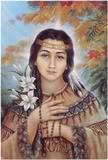Native American Roman Catholic Nun
Lily of the Mohawks, as she is popularly known, was the first recorded Native American Roman Catholic nun in North America. She was born in 1656 at Gandawague Castle near Fonda, New York, to a Mohawk father and a Christianized Algonquin mother. Her mother had been taken captive by the Iroquois and given as wife to the chief of the Mohawk clan, the boldest and fiercest of the Five Nations.
When she was four, Kateri lost her parents and little brother in a smallpox epidemic that left her disfigured and half blind. She was adopted by two aunts and an uncle, who succeeded her father as Mohawk chief, but she was left largely on her own.
Her uncle hated the coming of the Blackrobes (Jesuit missionaries), but could do nothing to them because a peace treaty with the French required their presence in villages with Christian captives. At the age of ten, Kateri was moved by the words of the missionaries who lodged with her uncle, but fear of him kept her from seeking instruction.
Tekakwitha grew into a young woman with a sweet, shy personality. She helped her aunts work in the fields where they grew corn, beans, and squash, and took care of the traditional longhouse in which they lived. She went to the neighboring forest to pick the roots needed to prepare medicines and dyes. She collected firewood in the woods and water from a stream. Despite her poor vision, she also became very skilled at beadwork.
Although Tekakwitha was not baptized as an infant, she had fond memories of her mother and of the stories of the Catholic faith that her mother shared with her. These remained indelibly impressed upon her mind and heart and were to give shape and direction to her life’s destiny. She often went to the woods alone to speak to God and listen to Him in her heart and in the voice of nature.
When Tekakwitha was eighteen, Father de Lamberville, a Jesuit missionary, came to Caughnawaga and established a chapel. Kateri vaguely remembered her mother’s whispered prayers, and was fascinated by the new stories she heard about Jesus Christ, Son of the Holy Virgin. She wanted to learn more about Him and to become a Christian, and refused to marry a Mohawk brave.
Father de Lamberville persuaded her uncle to allow Tekakwitha to attend religious instruction classes. The following Easter, twenty-year-old Tekakwitha was baptized. Radiant with joy, she was given the name of Kateri, which is Mohawk for Catherine. She was powerfully moved by God’s love for human beings, and saw the dignity of each of her people.
Kateri’s family did not accept her choice to embrace Christianity. After her baptism, Kateri became the village outcast. Her family refused to give her food on Sundays, because she wouldn’t work on the Sabbath. Children taunted and threw stones at her. She was threatened with torture or death if she did not renounce her religion.
Because of increasing hostility from her people and because she wanted to devote her life to God, in July of 1677, Kateri left her village and fled more than 200 miles through woods, rivers, and swamps to the Catholic mission of St. Francis Xavier at Sault Saint-Louis, near Montreal, Canada. Her journey took more than two months. Because of her determination to prove herself worthy of God and her undying faith, she was allowed to receive her First Holy Communion on Christmas Day, 1677.
Although not formally educated and unable to read and write, Kateri led a life of prayer and religious practices. She taught the young and helped those in the village who were poor or sick. Her favorite devotion was to make crosses out of sticks and place them throughout the woods. These crosses served as stations that reminded her to spend a moment there in prayer.
When the winter hunting season took Kateri and many of the villagers away from the village, she made her own little chapel in the woods by carving a cross on a tree and spent time in prayer there, kneeling in the snow. Kateri loved the rosary and carried it around her neck always.
On March 25, 1679, Kateri made a vow of virginity, meaning that she would remain unmarried and totally devoted to Christ for the rest of her life. Kateri hoped to start a convent for Native American sisters in Sault St. Louis, but her spiritual director, Father Pierre Cholonec, discouraged her.
In her zeal to obtain complete penance, Kateri persuaded a friend to whip her, in the custom of the day – a practice that she followed every Sunday for a year. Although the savage whippings became too much for her body to withstand, she resolutely continued the practice. Father Cholonec encouraged Kateri to take better care of herself, but she laughed.
Kateri became infected with tuberculosis, which made her weak and very ill. Over time, the disease took away all of Kateri’s strength, and finally took her life.
Kateri Tekakwitha died on April 17, 1680, at the Ville Marie of St. Francis Xavier, at the age of twenty-four. Her last words were, Jesus, I love You. Like the flower she was named for, the lily, her life was short and beautiful. She was buried near La Prairie, Quebec.
Witnesses said that when she died, her emaciated face changed color and became that of a healthy child. The lines of suffering, even the pockmarks, disappeared and the touch of a smile came upon her lips.
It is believed that Kateri has performed many miracles since her death, curing the sick and helping those in need through their prayers to her. Her devotions and self-denial were so remarkable that many miraculous visions were claimed in her name. Fifty years after her death, a convent for Native American nuns was opened in Mexico.
In 1943, the Catholic Church declared Kateri venerable, the first step in becoming a saint. This takes place when it is believed that a miracle is performed through the belief and prayer of those still living. Once the candidate has been declared venerable, the next step is to be declared beatified.
Kateri was beatified in 1980 by Pope John Paul II. Beatification is a process that takes place when the cardinals of the church decide that the candidate has performed a true divine miracle. This is when the Pope proclaims that the servant of God is to be venerated as a blessed. When the candidate has been declared a blessed, it takes some time for the process of Sainthood to occur.
Kateri Tekakwitha is the first Native American to be declared blessed. Pope John Paul II also designated her as a patroness for World Youth Day in 2002. Her feast is celebrated on July 14th in the United States.
SOURCE
Lily of the Mohawks






